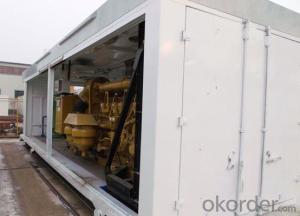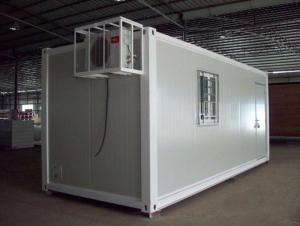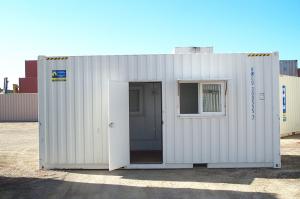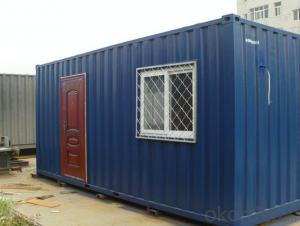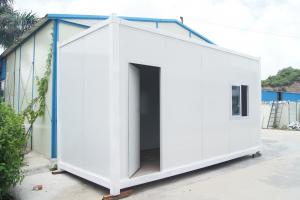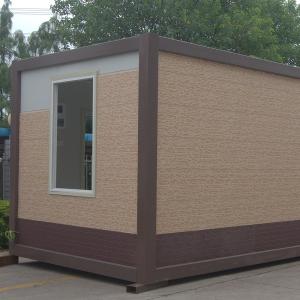container homes
- Loading Port:
- Tianjin
- Payment Terms:
- TT OR LC
- Min Order Qty:
- -
- Supply Capability:
- 20000 Set set/month
OKorder Service Pledge
OKorder Financial Service
You Might Also Like
Popular Sold Prefabricated Container House
container homes for sale
House Size:
1) External length /inner length: 5950mm/5700mm
2) External width/inner width: 2310mm/2060mm
3) External height/inner width: 2740mm/2400mm
4) Floors: max 3 floors
House Body:
1) Door: outside door as SIP door, aluminium alloy door or security door.
inside door as SIP door, aluminium alloy door or Compound wooden door
2) Window: PVC material or aluminium alloy with window screen
3) Wall system: sandwich panel's insulation material of sandwich panels are
EPS/XPS/PU/ROCK WOOL, GLASS WOOL, etc. The thickness: from 50mm to
100mm
4) Roof system: knock down in factory
5) Compression decorative parts: made of 0.4mm thick color steel sheet
6) Ceiling board: EPS color steel sandwich panel, rock wool, PU for the
insulation or MDF plate mobile container house
Design technical data:
1) Wind load: 0.65KN/sqm
2) Roof live load: 0.5KN/sqm
3) Earthquake intensity: 8 grade
4) Location temperature:-25ºC to 45ºC
Installation efficiency:
Four skilled labors can assemble 1 set house body in 2 hours.
Container transportation:
Every 40HQ may load 6 sets houses body stuff.
- Q:Are container houses suitable for families with children?
- Depending on their specific needs and preferences, container houses can be a viable choice for families with children. They present several advantages that make them suitable for such families. To begin with, container houses can be tailored and customized to provide ample living space for families. By combining, stacking, or modifying containers, multi-level homes can be created to accommodate the growing needs of a family. Through careful planning and design, these houses can offer multiple bedrooms, bathrooms, and functional living areas that are well-suited for families with children. Moreover, container houses can be cost-effective, making them an appealing option for families on a budget. Containers are relatively inexpensive and can be repurposed into homes, resulting in cost savings compared to conventional housing options. This affordability allows families to allocate more resources towards their children's education, health, and other needs. Additionally, container houses offer flexibility in terms of location. They can be placed on various terrains, including rural or remote areas, providing families with the opportunity to live in a tranquil environment away from the city's hustle and bustle. This can be advantageous for children, as it allows them to grow up in a serene and natural setting. Furthermore, container houses can be energy-efficient and environmentally friendly. With proper insulation, these houses can maintain comfortable temperatures year-round, reducing the need for excessive heating or cooling. This results in lower energy bills and a smaller carbon footprint, which is crucial for families who prioritize sustainability and teaching their children about eco-friendly living practices. However, it is important to consider certain potential challenges when considering container houses for families with children. Additional modifications may be necessary to ensure the safety and comfort of children. For instance, stairs and balconies may need to be built or reinforced to prevent accidents. Adequate insulation and ventilation should also be taken into account to maintain a healthy living environment for children. In conclusion, container houses can be a suitable option for families with children, providing affordable and flexible housing solutions. Nonetheless, careful planning and modifications are essential to guarantee the safety and comfort of children. Ultimately, the suitability of container houses for families with children will depend on individual preferences, lifestyle, and the specific needs of each family.
- Q:Can container houses be designed with a home gym?
- Container houses are certainly capable of being designed with a home gym. These houses offer a high level of customization, making it possible to transform them into any kind of living area, including a home gym. The adaptable and open layout of container houses allows for the inclusion of various amenities, such as exercise equipment, weights, and even room for yoga or aerobics. Moreover, containers can be modified to feature large windows or skylights, which bring in natural light and create a spacious atmosphere within the home gym. With careful planning and design, container houses can be personalized to meet individual fitness needs and preferences, resulting in a functional and convenient workout space inside the container.
- Q:Can container houses be transported easily?
- Yes, container houses can be easily transported. Due to their modular design and standard size, they can be easily loaded onto trucks, ships, or trains and transported to different locations.
- Q:Can container houses be rented or leased?
- Indeed, one has the option to rent or lease container houses. Numerous individuals or companies extend the opportunity to rent or lease container houses as an alternative housing choice. Opting to rent or lease a container house can prove to be an economical answer for those seeking temporary or adaptable lodging. These residences can be tailored to suit the renter's desires and requirements, and can be effortlessly relocated to various destinations. Furthermore, renting or leasing a container house grants individuals the chance to embrace the minimalist and sustainable way of life that accompanies residing in a container home, devoid of the obligation to make a purchase.
- Q:How durable are container houses?
- Container houses are highly durable structures as they are made from sturdy materials such as steel and have been designed to withstand harsh weather conditions, including strong winds and earthquakes. With proper maintenance and reinforcement, container houses can last for several decades, making them a reliable long-term housing solution.
- Q:Are container houses resistant to termites or other wood-damaging insects?
- Container houses are generally resistant to termites and other wood-damaging insects. This is because most container houses are made from steel or metal, which termites and other insects do not typically target. However, in some cases, container houses may have wooden elements such as flooring or interior finishes that could be susceptible to termite damage. In such instances, it is important to take preventive measures such as treating the wood with termite-resistant chemicals or using alternative materials to minimize the risk of infestation. Additionally, regular inspections and maintenance can help identify and address any potential termite or insect issues promptly. Overall, while container houses offer a higher level of resistance to termites and wood-damaging insects compared to traditional wooden houses, it is important to remain vigilant and take necessary precautions to ensure long-term durability and protection.
- Q:Are container houses suitable for remote working spaces?
- Yes, container houses can be suitable for remote working spaces. They provide flexibility and can be customized to create functional and comfortable work environments. With proper insulation, ventilation, and amenities, container houses can offer a quiet and productive setting for remote work. Additionally, their portability allows for easy relocation to different remote locations, making them a convenient option for those who frequently change their work environment.
- Q:Are container houses resistant to hurricanes or strong winds?
- Proper design and construction can render container houses resistant to hurricanes and strong winds. The modifications made to shipping containers greatly impact the structural integrity of container houses. To enhance their ability to withstand extreme weather conditions, reinforcements like additional steel beams, concrete foundations, and hurricane straps can be incorporated. Container houses engineered to endure hurricanes and strong winds typically comply with specific building codes and regulations. These regulations carefully consider factors such as wind speed, uplift forces, and overall structural stability. By adhering to these guidelines, container houses can be fortified against high winds and storms. It is important to emphasize that the location of a container house also plays a pivotal role in its hurricane resistance. If the house is situated in an area prone to hurricanes, additional precautions may be necessary to ensure durability. These precautions could involve securing the house to a solid foundation, utilizing impact-resistant windows, and implementing effective drainage systems to prevent flooding. In conclusion, container houses have the potential to resist hurricanes and strong winds. However, it is essential to collaborate with experienced professionals who comprehend the specific requirements for constructing in high-wind regions. By implementing the necessary modifications and adhering to building codes, container houses can offer a secure and long-lasting living space, even in areas susceptible to severe weather conditions.
- Q:Are container houses suitable for retirement living?
- Depending on one's preferences and needs, container houses can be a viable choice for retirement living. One major advantage of container houses is their affordability in comparison to traditional housing options. This is especially beneficial for retirees who have limited financial resources or are seeking to downsize and reduce expenses. Furthermore, container houses offer a high level of customization, allowing retirees to design a living space that caters to their specific requirements. They can be modified to include features such as easy accessibility ramps, wider doorways for mobility aids, and open floor plans to minimize excessive movement within the house. In addition, container houses are generally low-maintenance and energy-efficient. They are constructed using durable materials that require minimal upkeep, lessening the maintenance burden for retirees. Moreover, container houses can be equipped with eco-friendly features like solar panels and rainwater harvesting systems, which contribute to lower utility costs and reduced environmental impact. However, it's important to consider potential drawbacks of container houses for retirement living. Limited space might not be suitable for retirees who require more storage or dedicated areas for specific hobbies or interests. Additionally, container houses may not be situated in traditional retirement communities or neighborhoods, affecting the social aspect of retirement living for those who value community engagement and interaction. Ultimately, the suitability of container houses for retirement living hinges on the individual's preferences, financial situation, and specific needs. Retirees should thoroughly evaluate their requirements and explore all available options before making a decision. Seeking guidance from professionals in the field, such as architects or retirement living experts, can also provide valuable insights in determining the optimal housing solution for retirement.
- Q:Can container houses be designed with a home gym or fitness room?
- Yes, container houses can certainly be designed with a home gym or fitness room. The versatility and customizable nature of container houses allow for various modifications to meet specific needs and preferences. With proper planning and design, a container house can easily accommodate a dedicated space for exercise and fitness activities. Container homes can be designed with enough space to house gym equipment such as treadmills, elliptical machines, weightlifting racks, and exercise bikes. The interior layout can be optimized to provide an open and spacious area, ensuring ample room for workout routines. Additionally, container houses can be equipped with appropriate flooring, mirrors, and ventilation systems to enhance the functionality and comfort of the fitness space. The insulation and soundproofing capabilities of container homes also contribute to creating an ideal environment for a home gym. These houses can be designed to regulate temperature and minimize external noise, allowing for a more enjoyable and focused workout experience. Furthermore, containers can be stacked or interconnected to create multi-level designs, which can be advantageous for incorporating a home gym. This design flexibility enables the allocation of an entire floor or a designated area solely dedicated to fitness activities, separate from the living spaces. In summary, container houses offer great potential for integrating a home gym or fitness room. With careful planning, customization, and attention to the specific requirements, container homes can be designed to provide a functional and convenient space for exercise and fitness enthusiasts.
1. Manufacturer Overview |
|
|---|---|
| Location | |
| Year Established | |
| Annual Output Value | |
| Main Markets | |
| Company Certifications | |
2. Manufacturer Certificates |
|
|---|---|
| a) Certification Name | |
| Range | |
| Reference | |
| Validity Period | |
3. Manufacturer Capability |
|
|---|---|
| a)Trade Capacity | |
| Nearest Port | |
| Export Percentage | |
| No.of Employees in Trade Department | |
| Language Spoken: | |
| b)Factory Information | |
| Factory Size: | |
| No. of Production Lines | |
| Contract Manufacturing | |
| Product Price Range | |
Send your message to us
container homes
- Loading Port:
- Tianjin
- Payment Terms:
- TT OR LC
- Min Order Qty:
- -
- Supply Capability:
- 20000 Set set/month
OKorder Service Pledge
OKorder Financial Service
Similar products
New products
Hot products
Hot Searches
Related keywords
